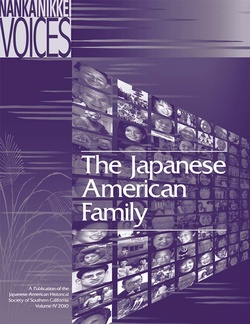The Japanese American Historical Society of Southern California launched their fourth publication, Nanka Nikkei Voices: The Japanese American Family, in September 2010. The following is a shortened version of the introduction to the volume written by guest editor Naomi Hirahara.
Introduction
I’ve traveled a lot domestically, but I haven’t necessarily spent much time in destination locales. Sure, there have been trips to New York City and Hawaii, but more have been vacation days in the farmlands of California and the wide-open “fly-over” towns in the Midwest.
Along the fog-covered Highway 99 in Central California, where Japanese America on the mainland was birthed in agricultural utopias, there is little evidence that the Issei had once been there, aside from the name of a Livingston grammar school, Yamato Colony Elementary School. Further north in Gold Country is a simple, adorned headstone where the first Japanese woman who died on American soil, Okei, is buried-but no real explanation of how and why these original travelers from Japan chose to come to California.
That’s perhaps why home—Southern California—is so darn important. Its geography is like a spider web-unwieldy, complicated, yet gorgeously expansive. You can go to the core of Japanese America, Little Tokyo, or decide instead to travel to the outposts of South Bay, Sawtelle/Venice, Crenshaw District, San Gabriel Valley, San Fernando Valley, Orange County, San Diego, Riverside, Imperial Valley, and Ventura County. And while I always have admired the compactness and aesthetic of San Francisco and the languid, liquid beauty of Hawaii, I’ve come to appreciate that Southern California is indeed the center of Japanese America.
So, it’s very appropriate that the Japanese American Historical Society of Southern California has selected “Japanese American Family” as its subject matter for its latest Nanka Nikkei Voices series. Not to say that either “Japanese American” or even “family” has one simple definition. In my own family, my parents’ first grandchild is a beautiful boy who shares not only Japanese but European and African heritage. Although his last name is Hirahara, he will most likely interpret and embrace his Japaneseness a lot differently than I do.
Family itself has its own ambiguity. With divorce, remarriages, blended families, adoptions, and same-sex couplings, the concept of family is more diverse than ever. Does combining “Japanese American” with “family” then make for an even more watered-down topic?
As it turns out, although Japanese American culture and values cannot sometimes be obviously seen or heard, it still very much exists for this volume’s essayists. We begin the book with very concrete thoughts and memories by Nisei, second-generation Japanese Americans, expressed in focus groups organized by Nanka Nikkei Voices founder and essential shepherdess Iku Kiriyama. Jenni Kuida and Tony Osumi’s classic “The 101 Ways to Tell If You’re JA,” originally published in The Rafu Shimpo newspaper during my editorial tenure, is reprinted as well.
The rest of the book is divided into five thematic sections: “Cultural Values,” “Rituals, Traditions, Celebrations,” “Family Stories,” “Home, Place, Community,” and “Crossing Generations.” The “Cultural Values” section is filled with observations both poignant and humorous. Educators, the late George Kiriyama and Kiyo Fukumoto, first provide a key of common values identified by sociologists, while Iku, a former teacher with the Los Angeles Unified School District, and former community college president Jack Fujimoto and his wife Grace Toya Fujimoto provide us with autobiographical examples for values such as gaman, shikataganai and haji. The prevalence of silence and restraint within parent-child interactions is evident in many of the stories, such as the ones told by Roy Sakamoto in “My Name Is Baka,” and Bill Watanabe in “The Screen Door.” The important role of preserving and reusing material objects, as it relates to such concepts as mottanai, is elaborated by Ariel Okamoto and Yoshio Nishimoto, who represent two very different generations. Role models figure prominently Naomi Otani’s piece, while both Grace Naoko Serizawa and Brian Niiya discuss how cultural values are and are not passed down to future generations.
If you have not before been exposed to the wealth and beauty of Japanese cultural terms, be prepared to be bathed in them here.
The next section, “Rituals, Traditions, Celebrations,” can be experienced more through the senses of taste, hearing, and sight. Traci Kato Kiriyama launches this section with the poem, “salted hands,” which mentions a grandfather’s lobster recipe in addition to a Nisei mother’s hard-to-reproduce rice ball. The grilled shishito, on the other hand, is the subject of an essay penned by Mari Nakano, who ties together memories of her late father with the Buddhist festival of Obon. And for Gwen Muranaka, the current English editor of The Rafu Shimpo, it’s the emblematic kaki, or persimmon, which brings to mind family and farming.
Gatherings surrounding food are essential to Japanese American life, as outlined in Becky Kato’s “Hazy Days of Summer.” The joy and stickiness of making New Year’s mochi are celebrated in Qris Yamashita’s piece, while UCLA Professor Valerie Matsumoto humorously captures the intensity of holiday preparation in her first line, “I never understood why people were more likely to murder relatives than strangers until I attended an extended-family New Year’s celebration.” Yonsei Nicole Akemi Arra remembers the role of soba noodles in her grandmother’s New Year tradition.
Holiday rituals definitely have their downsides, especially when the heart and purpose of them have been forgotten. Both Brian Niiya and Sharon Yamato deftly tackle these issues with both humor and pathos. And Alex Isao Herbach adds levity to his own experience as a “Jewpanese” in his celebration of “ChrismaShogaNukkah.”
This section also includes the way Japanese and Japanese Americans recognize birth and death. Lesser known are significant years of celebration: Iku Kiriyama provides a brief primer of these ages and their significance. The popular practice of koden, the giving of money to the bereaved during a funeral, is documented anecdotally by Patti Dozen. Two religious leaders, Rinban Noriaki Ito and Reverend Masao Kodani, provide the Buddhist roots of koden and Obon, respectively.
The “Family Stories” section leans toward the personal. Educator and artist Tony Osumi starts us off with the poem, “A Fearless Passing,” which celebrates the Jinglish of Obaachan and Ojiisan. There’s more poetry—specifically haiku—by Kimiyo Ige’s mother in “A Creative Edge.”
Individual family stories reveal much about the history of certain far-flung neighborhoods: George Minoru Wakiji (Pasadena), Ike Hatchimonji (El Monte), Sets Asano (New Orleans), Reverend Dr. Paul M. Nagano (Canada and Boyle Heights), and Kiyo Fukumoto (Mexico). Both Iku Kiriyama and Wimpy Hiroto spotlight the strengths and accomplishments of a close family member.
The section is wrapped up in an academic piece, “to what degree is the Japanese American Family ‘Japanese’?” Written by two social workers, the late Paul Chikahisa and Dr. Noreen Mokuau, the paper examines how social factors, such as discriminatory legislation and intermarriage, have impacted family structure.
The fourth section, “Home, Place, Community,” builds upon the previous and studies various Nikkei communities. Movement, both forced and voluntarily, is present in most of these individual stories. Marie Mariko Masumoto covers Chicago, Japan, Los Angeles, and Torrance in her family history. Harry Honda, editor emeritus of the JACL house organ, Pacific Citizen, describes how he has been able to stay connected with a cousin who lives in Japan. Takako Fujimura pays tribute to the Hawthorne Gakuen Japanese school, while Kay Ochi takes a closer look at San Diego in the fifties and sixties. Janet Hironaka remembers significant years of her young life in Hawaii through the eyes of her father, and Mishele Miyake writes how her grandfather, Akemi Miyake, pioneered strawberry growing in Orange County.
Certain community institutions are also the subject of our essayists. Bill Watanabe, executive director of Little Tokyo Service Center, revisits Saturday Japanese-language schools. Margaret Miyauchi Leong takes on the Kagoshima Heritage Club, one of the more active kenjinkai (prefectural associations). Chris Komai, public information officer of the Japanese American National Museum and grandson of a key leader of The Rafu Shimpo, traces the history of this Japanese American daily newspaper, which has served as the chronicler of various community activities for more than a century. Nikkei basketball leagues, the Sansei/Yonsei generations’ connecting glue, are the focus of both Ellen Endo, another former Rafu editor, and Edward K. Takahashi. Heritage schools, as described by Iku Kiriyama, also serve to pass along a sense of community to young people.
No volume on the Nikkei family can ignore the effect of the incarceration of Japanese Americans in U.S. concentration camps. Jim Matsuoka's “Stray Cats of Manzanar” dwells on how the absence of family in camp left young boys to their own devices. In an excerpt of his dissertation, Ford Kuramoto outlines how Shonien, an L.A.-based orphanage, became part of Children's Village in Manzanar War Relocation Center.
Our final section, “Crossing Generations,” takes all of our themes into the 21st century. Traci Kato Kiriyama pays tribute to past generations in the effective poem, “it is your fault.” As Japanese Americans have the highest out-marriage rate among other Asian Americans, it is no surprise how intermarriage and mixed-race children are the focus of Glenn Suravech’s and Bob Takeuchi’s respective essays. Two young women, Mari Nakano and Samantha Masunaga, muse on what it means to be an American of Japanese descent for the Yonsei generation. Mari Nakano, who lacks clues regarding her ancestors, wonders how she will piece together her identity in the future, while Janna Abo George is inspired by the time spent with her grandmother. Jenni Kuida reflects that her own love for gardening was originally instilled by her four-and-a-half foot tall grandmother, “a gardening giant.”
Bringing home the topic of silence full circle, Brandon Shindo and Molly Mayumi Serizawa both poignantly share how they have been affected and moved by their respective grandfathers’ sense of restraint. Shindo finds himself pursuing his late grandfather’s avocation, fishing. Serizawa, meanwhile, successfully teaches her grandfather to clearly verbalize, “I love you.”
Iku Kiriyama ends the volume with a glossary of Japanese and Japanese American terms and words. It is precisely these words that generated a lot of discussion and debate during our editorial meetings, attended by Iku, Martha Nakagawa, Jenni Kuida, and me.
For those who have experienced great loss or brokenness in terms of their family, I believe family goes beyond blood. It can consist of two people and include a community of friends. The Japanese American family has survived racist laws regarding immigration and employment, forced removal from its roots on the West Coast, and suspicions about “foreignness.” Yet an essential ingredient to Japanese America is “America”—that being family here is not the same as being family in Japan. These values from the old country have been mixed and stirred together with the plight, suffering, freedom, and joy of being American. I hope that the gold in these values continues to be purified throughout the generations, bringing loveliness and strength to our community, nation, and world.
* * *
Panel discussion—NNV: Interactive Panel
Saturday November 13, 2010
3-4 pm
Torrance Katy Geissert Civic Center Library
Interactive panel with writers from Nanka Nikkei Voices: The Japanese American Family who will read and share stories related to immigration experiences, Issei values, Issei/Nisei parenting, childhood, and impact on adulthood.
* * *
© 2010 Japanese American Historical Society of Southern California






